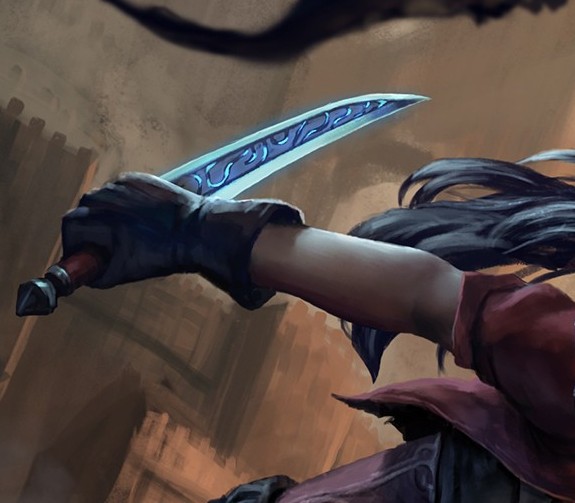Dagger (weapon)
Daggers, also dirk, kirpan or tanto, are fighting knife between 11 and 18 in. long, typically double-edged and intended for stabbing, thrusting or throwing. They're commonly forged from hard iron or steel and feature a minimal guard and a pommel, tapering to a sharp point. A narrow groove known as a blood gutter runs along the flat of the blade, not to channel blood but as part of the forging process to reduce weight and maintain strength. Daggers are a preferred weapon of illusionists and mages, and are also used to a lesser degree by bards, druids, monks and thieves.
Contents
In many societies, daggers carry social and symbolic weight beyond its practical use, often associated with assassination, duelling or codes of honour. Styles vary widely across regions, with some featuring elaborate hilts or inscriptions, especially when intended as gifts or marks of rank. While not ideal against armoured foes, the dagger excels in close quarters, where its speed and precision can be decisive. In civilian life, they're frequently carried for utility, such as cutting rope, preparing food or as a last resort for self-defence. In urban centres or courtly settings where larger weapons are restricted or impractical, daggers may be the only arms permitted, making them essential for self-protection and political intrigue alike.
Combat
Damage from the dagger is 1–4, modified by the wielder's strength, reflecting the force behind a close-quarters strike. When thrown, its short length and light weight limit both range and accuracy, making it unreliable at any significant distance. A character with exceptional dexterity, however, can compensate for this drawback by controlling the spin and angle of release with greater precision, increasing the chance of a hit. When a hit lands, thrown daggers rarely penetrate deeply unless a critical hit has occurred — in which case the weapon should be assumed to have deflected off (and may need to be checked to see if it has broken, depending on the environment). There is a 1 in 6 chance of a dagger breaking if it's dropped or thrown against a stone or metal surface.
| Bow | Point Blank |
Short | Medium | Long |
|---|---|---|---|---|
| Dagger | 2 | 3-5 | 6-9 | 10-12 |
Weighing just one pound, the dagger is light enough to be carried unnoticed beneath a cloak or tucked into a boot, making it a natural choice for those who rely on stealth or misdirection. Though not as easily hidden as a short knife, it offers greater lethality in exchange for slightly more bulk. Its manageable size allows it to be drawn swiftly with 1 action point, a crucial advantage in moments where speed determines survival.
The weapon’s short reach makes it unsuitable for mounted combat except when thrown, where it serves more as a last resort than a reliable attack. Despite its limitations, it remains widely used due to its accessibility and versatility. The dagger is designated as a hereditary weapon for characters raised in the Rhineland, reflecting both regional custom and the prevalence of dagger-use in trades and professions associated with stealth, confinement, and subterranean work. Characters whose progenitor was an assassin, fence, guildmaster thief, gypsy, miner, or rat catcher gain a +1 bonus to hit when using a dagger, representing both ingrained familiarity and a lifetime of situational application where the blade’s quickness and precision were essential to survival.
Characteristics and Background
Daggers are commonly used by many creatures and races as a weapon, including dryads, erinyes, homonculi, locathah, mites, naga and sea hags. Their widespread adoption speaks to the weapon’s adaptability across physical forms, environments and combat styles. For smaller creatures such as mites or homonculi, the dagger serves as a primary weapon, proportioned to their size and strength while still delivering lethal precision. Aquatic races like the locathah and sea hags favour daggers for their ease of use underwater, where larger weapons create drag and are difficult to wield. The dagger’s ubiquity among such varied beings makes it one of the most encountered weapons across regions and planes, recognised by its shape and use even where cultural overlaps are minimal.
The main-gauche sage ability allows a character to wield a dagger as both an offensive weapon and a defensive tool, effectively substituting for a shield. When used in this manner, the character gains a +1 bonus to armour class (AC), regardless of whether the dagger is employed to attack. This technique mirrors historical practices from the Renaissance and Baroque periods, where a dagger was held in the off-hand to parry attacks while the dominant hand wielded a sword. In game terms, the off-hand weapon must not exceed 3½ lbs. Characters with a dexterity of 13 or higher may attack with both weapons in a single round. Additionally, if a character has multiple attacks per round, the dagger can be used for one of these attacks, even if the character's dexterity is below 13. This is particularly advantageous when the dagger possesses magical properties.
The dagger of venom is a magic item that injects a fatal poison when a critical hit is rolled. The poison is magically contained within the weapon and does not degrade over time, nor is it affected by exposure to water, heat or common antidotes. On a successful critical hit, the poison is automatically delivered into the wound through hidden channels or enchantment-bound grooves in the blade, bypassing most forms of natural resistance. The effect is instantaneous, requiring no additional action or decision by the wielder.
